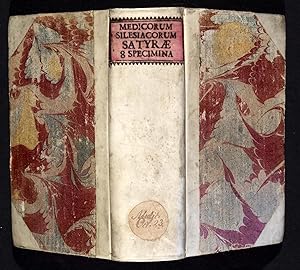early silesian medical journal including von medicorum silesiacorum satyrae quae varias (1 Ergebnisse)
Produktart
- Alle Product Types
- Bücher (1)
- Magazine & Zeitschriften
- Comics
- Noten
- Kunst, Grafik & Poster
- Fotografien
- Karten
- Manuskripte & Papierantiquitäten
Zustand
- Alle
- Neu
- Antiquarisch (1)
Einband
- alle Einbände
- Hardcover (1)
- Softcover
Weitere Eigenschaften
- Erstausgabe (1)
- Signiert
- Schutzumschlag
- Angebotsfoto (1)
Gratisversand
- Versand nach USA gratis
Land des Verkäufers
Verkäuferbewertung
-
Early Silesian Medical Journal including treatment of rheumatism, cataracts, hermaphroditism & male sterility
Verlag: Breslau & Leipzig, Johann Jakob Korn, 1736-1742, 1736
Anbieter: Hünersdorff Rare Books ABA ILAB, London, Vereinigtes Königreich
Buch Erstausgabe
Hardcover. Zustand: Fine. No Jacket. 1st Edition. [Burghart, Gottfried Heinrich, editor] Medicorum Silesiacorum satyrae: quae varias observationes, casus, experimenta, tantamina ex omni medicinae ambitu petita exhibent: specimen I-VIII] cum figures. 8 parts in l volume, 8vo. [10] + 103 + [1]p; 3 engraved plates; 103 + [1]p; 3 engraved plates; 95 + [1]p; 3 engraved plates; 103 + [1]p; 1 engraved plate; 103 + [1]p; 1 engraved plate; 128 + [2]p; 110 + [2]p; 162 + [22]p. (final 4 leaves with errata for all parts). First title in red & black with oval library stamp. Contemporary half vellum; marbled boards; red title label on spine; book block in red. First edition of this rare early Silesian scientific periodical complete in eight parts (specimen), each with a separate title page and pagination, edited by Gottfried Heinrich Burghart (1705-1776), born in Reichenbach, Lower Silesia, chemist and physician at Breslau, who is best known for his Destillier-Kunst (1747), one of the standard 18th century works on distilling. Burghart was later professor of mathematics and physics at Brieg (Brzeg) College in Lower Silesia, and supervisor of the mines at Reichenstein and Silberberg. Subjects treated include rheumatism, cataracts, hermaphroditism & male sterility (3rd part contains a description of a Jewish boy with deformed genitals ( Puer Iudaeus, quod genitalia monstrosus, neque tamen Hermaphroditis adnumerandus ), apoplectics, minerals, salts, and observation of meteorites. Part I, p75 discusses the influential paper Von Nachahmung der Franzosen (on learning from French models) read in 1687 by the Leipzig philosopher and educator, Christian Thomasius , a pivotal figure in early 18th century German Enlightenment and the co-founder of Halle University. Thomasius (1655-1728) lectured in German as opposed to the traditional Latin, and recommended French use of the vernacular in scholarship. Part II, p95, contains a life of Johann Kanold (1678-1729), Breslau physician and noted plague epidemic scholar, who had recognized the contagious nature of cattle plague by a herd of infected zebus from India en route to Brazil. A fine copy with oval stamp of the Fürstensteiner Bibliothek, former library of the princes of Hochberg-Pless at Fürstenstein Castle in Lower Silesia in blank margin of first title. The collation is identical with that of the copy held by the Wellcome Library, London, which also contains a total of eleven plates. Ferguson, Biblioteca Chemica, I,132 ( In 1736 he began a collection of scientific and medical observations entitled Medicorum Silesiacorum Satyrae continued to 1742 in eight parts, and contains papers on mineral waters, salts etc. He seems to have had some belief in transmutation (the change of one chemical into another). Holzmann & Bohatta, Deutsches Anonymen Lexikon IV, 713. VD 18 90382986.


